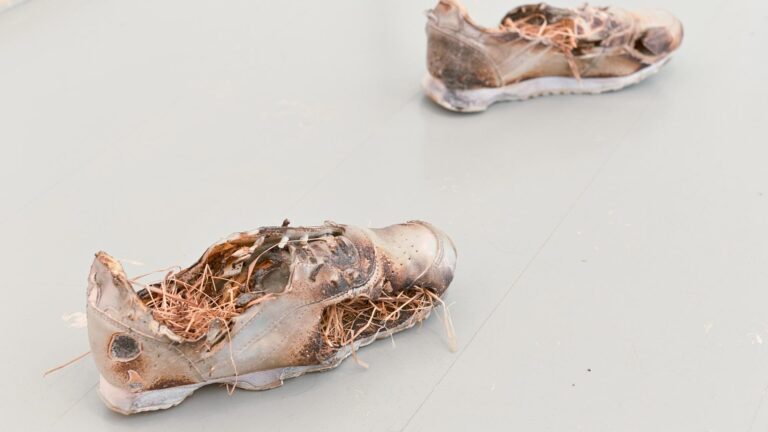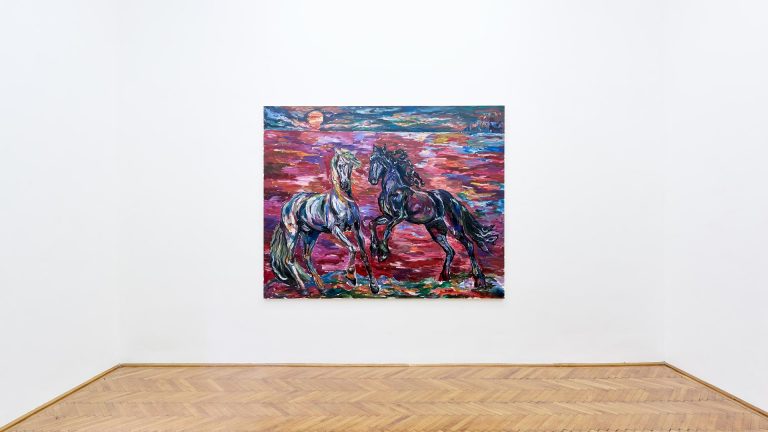Artists: Imre Bak, András Mengyán, György Szőnyei, Ottó Vincze
Exhibition title: Dolce Geo
Curated by: Gabor Rieder
Venue: Art+Text Budapest, Budapest, Hungary
Date: February 24 – March 19, 2017
Photography: Miklós Sulyok, Krisztián Zana, images copyright and courtesy of the artists and Art+Text Budapest
“Oh che dolce cosa è questa prospettiva!” (Oh, what a sweet thing is this perspective!), sighed Paolo Uccello who was unable to leave his studio after his wife entreated him to come to bed. The geometrical order enchanted not only the Quattrocento artists but also the architects, designers and painters of the postmodern era. In 1983 Imre Bak wrote, “Art is personal—it serves as a tool for constructing ourselves, it is a spiritual adventure that, after a long time of inactivity, seems to be more exciting than ever with the freedom we have nowadays. It also promises to be especially cheerful.” Having seen the figurative tendencies of “New Painting” (heftige Malerei, trans-avant-garde, etc.) Bak discovered new possibilities of joy and freedom in which he would indulge with his abstract approach thanks to the liberating influence of postmodern design and neo-geo.
The major postmodern exhibition in Victoria and Albert Museum in London (Postmodernism: Style and Subversion 1970—1990) was not well-received in 2011. However, in the last few years it has become clear in the field of design that the revival of postmodernism has begun – playful geometry, brash eclecticism, unique combination of pale colours and vivid palette, stirring solutions that are in contrast with the functionalist principle of modernism and the proverbial phrase „Less is more”. The pioneering Italian design and architecture groups, PoMo and Memphis Group, have become a focus of attention; Michael Graves’ iconic Portland Building (a monolithic cube with art deco ornaments) has been saved from demolition; and Nathalie Du Pasquier, former member of the Memphis Group, has teamed up with American Apparel. In the 1970s and 1980s postmodernism flourished mainly in architecture, graphic design and fashion design. It influenced painting in a more indirect way through the new wave/post-punk rebellion, the rediscovered artistic styles (ancient and classical architecture, art nouveau, art deco), the demand for New Painting of the 80s. There is another factor that helped postmodernism to seep into painting—it is the abstract patterns of neo-geo inspired by Jean Baudrillard’s notion of hyperreality and Robert Venturi’s eclecticism.
Neo-geo, short for neo-geometric conceptualism, is a term that emerged from New York’s East Village in the late 1980s. It is applied to the work of Peter Halley, Ashley Bickerton, Jeff Koons and others. They were influenced by different modern tendencies—such as minimalism, pop art and op art—but they used this language to criticize what Halley referred to as the ‘geometricisation of modern life’. “The modern conception of man as a machine is more economic than biological in its accent. It refers to the human robot rather than the human animal, and suggests an efficient control of the costly movements of the body, a submission to some external purpose indifferent to the individual”, wrote Halley.
The well-established art movement of neo-geo became popular in a short time with artists who did not want to adapt to the figurativeness of neo-expressionism. When Lóránd Hegyi attempted to collect the Hungarian neo-geo painters in an exhibition entitled Postgeometry at Fészek Gallery in 1987, Imre Bak undertook to review the related international tendencies in the catalogue from neo-constructivism to Geometria Nova, from Peter Halley to Gerwald Rockenschaub and John Armleder. According to Bak, the new approach of geometric abstraction reflected the postmodern Zeitgeist—“Only the multilayered meaning combinations can be considered universal. Even in the case of artists who work with minimal and emblematic forms. (…) The abstract forms of a Peter Halley painting can be easily transformed into an illuminated prison cell with bars. The difference is that the multiple meaning does not lessen the effect but it makes it extremely intense. ‘In postmodern culture everything is hyperreal (more intense than the real)’, says the philosopher Jean Baudrillard.”
Imre Bak (1939, Budapest) is one of the most important artists of the Hungarian neo-avant-garde who played a key role both in the reformation of the geometric art practice of the 80s and the incorporation of postmodern philosophy into art. Being a member of the IPARTERV generation, it was hard for him to find his place in a time when figurative painting dominated the art world, especially the Hungarian art scene, where a new tendency developed under the name of “New Sensibility” (the term was coined by the local super-curator Lóránd Hegyi). It was the Gallery of Józsefváros where Bak first saw the works of the Italian architect Mario Botta. He was amused by Botta’s playful motifs full of historic references and started to do a research on the topic—during the research he also came across the PoMo architecture and the iconic Italian design groups of the era (Memphis Group, Studio Alchimia). In 1983 he painted the paradigmatic triptych Quotations I—III with pastel ice cream colours, tiny patterns, axonometric blocks, new-wave zigzags and irregular wavy lines. The liberating painting (“This is who I really am”, he said later about this period) was followed by a prolific decade using both playful motifs and rich historic references.
Imre Bak’s painting finally found its place in the tendency of New Sensibility that would be shown later in various exhibitions in both Hungary and Western Europe. Lóránd Hegyi, organizer of the “group”, involved not only the emerging young painters but also the older generation in the shows. György Szőnyei (1951, Budapest), graduated at the Hungarian Academy of Applied Arts, represented the new generation—he also exhibited at the show Postgeometry in 1987. In the catalogue of the exhibition Hegyi wrote, “Postgeometry shown here as an autonomous art phenomenon is part of the radical eclecticism of the 80s in the same way as the works exhibited between 1981 and 1986. However, we witness the reinterpretation of a different layer of tradition of modernism here.” Because of the incorporation of different elements of styles and references, these abstract paintings have more to do with postmodern architecture than constructivism or post-painterly abstraction—they are characterized by ambiguity and reinterpretation. Hegyi added, “Actually, the structures of postgeometry are quasi structures, they are eclectic formations containing different visual elements that were composed according to the arbitrariness of aesthetic subjectivity.” In Szőnyei’s ironic postgeometry the abstract signs are fragments that place the non-figurative imprints of reality either into a typographical black-and-white set-up or a system made up of homogeneous colour fields. These elements vary from an imprint of a Nescafé coffee cup and the Communist symbol of hammer to a broken Mettlach tile and the rubber sole of a sneaker. Randomness plays an important role in Szőnyei’s working process—he finds the motifs by chance, then he enlarges them to an extent when the boundary between micro and macro reality becomes blurred. He says about his art, “Some create geometric situations, some work with geometric elements. I am interested in the latter. The source of inspiration can be anything; therefore the pattern of the composition (the story) is the consequence of the current ‘geometricisation’. In this way a spectacular formal phenomenon can be transformed into a geometric image. No theory.”
Ottó Vincze (1964, Kisvárda), an autodidact, did not participate in the exhibition Postgeometry—he joined the art community full of creative energy of Szentendre in the late 80s. He was influenced by, on one hand, the neo-dada approach and the new-wave aesthetics of the Lajos Vajda Studio, and, on the other hand, by the masters of the local constructivist school (Jenő Barcsay, Pál Deim, etc.). Vincze wanted to break free from the boundaries of the limiting constructivist tradition of Szentendre so he challenged the avant-garde geometric order with his shaped canvases and wooden carved motifs. Solid forms were replaced by unstable shapes balancing on their corner and zigzag patterns inherited from new-wave expressionism. Imre Bak wrote in his essay Turn in the 80s (Belvedere, 1989/3) that postmodern art owes a lot to the architectural theorist Charles Jencks who emphasized not only the role of geometric symbols and the integration of high and low cultures but also the synthesis of the “classical” (language), the “national” (specific local character) and the “technical” (typical elements of the present) phenomena. These ideas also appeared in the surrealist program of Szentendre that discovered vernacular motifs (e.g. Baroque volutes). The geometric motifs on Vincze’s neo-geo canvases carry local meaning—they are reductions of symbols related to local history, such as the cross of the old commercial company of Szentendre or the symbols of the local Serbian orthodox church.
In contrast with the three abovementioned artists, András Mengyán’s painting (1945, Békéscsaba) is usually not regarded as postmodern in Hungary. However, his Norwegian critic Gunnar Danbolt calls him a “post-modernist – new modernist” in his essay wrote in 1995. Mengyán was a member of the second generation of the Hungarian neo-avant-garde and his artistic approach was determined by structuralist form studies and seriality in the beginning. “Since my art is characterized by a philosophical thinking,—he writes in his essay Form Theory—I use the language of abstract (geometric) forms in order to realize my ideas. (…) Besides these kinds of works, (my instincts does not let me rest) I create works that are the results of the effects caused by other people. These works come into existence as a consequence of my anger, dissatisfaction, disagreement or new visions.” The influence of postmodernism is obvious in Mengyán’s paintings that were made in the late 80s (Position pictures I—IV, 1987)—it is reflected in the levitating geometric shapes and symbols in the space. This visual effect reappears in his major series of 1992, too. Its pieces come to life in a spectacular way by illuminating them with UV light. Thanks to the photoluminescent pigments, the acrylic paintings—depending on the lighting—become duplicated. The dimensions of the descriptive geometric figures break and the objects step into the space with the result of a playful combination of forms.
After the exhibition of Peter Halley and Imre Bak (Diagonal Histories) in the gallery’s first year, Art+Text Budapest submerges again in the abstract world of postmodern Hungarian art of the 1980s, in the universe of “sweet geometry” paying tribute to neo-geo. The show aims to offer a new perspective on a unique selection of artworks by four artists who have never exhibited together in such context before — the show can be regarded as the first step towards the rediscovery of Hungarian painting of the 1980s.
—by Gabor Rieder
Dolce Geo, Exhibition view at Art+Text Budapest, 2017
Dolce Geo, Exhibition view at Art+Text Budapest, 2017
Dolce Geo, Exhibition view at Art+Text Budapest, 2017
Dolce Geo, Exhibition view at Art+Text Budapest, 2017
Dolce Geo, Exhibition view at Art+Text Budapest, 2017
Dolce Geo, Exhibition view at Art+Text Budapest, 2017
Dolce Geo, Exhibition view at Art+Text Budapest, 2017
András Mengyán, Information fragments, 1992, akril, fluorescent UV pigments on canvas, 200×140 cm
András Mengyán, War of isms, 1992, akril, fluorescent UV pigments on canvas, 200×200 cm
György Szőnyei, Luna, 1986, dispersit on wood, 165×420 cm (each)
György Szőnyei, Two Countryman, 1986, dispersit on wood
Imre Bak, Antigravitation, 1987, acrylic on canvas, 200×150 cm
Imre Bak, Charlston, 1987, acrylic on canvas, 200×150 cm
Ottó Vincze, Anarchoid Poesie, 1989, acrylic on canvas and plywood, 250×200 cm
Imre Bak, Red Cross, 1992, acrylic on canvas, 120×80 cm





















